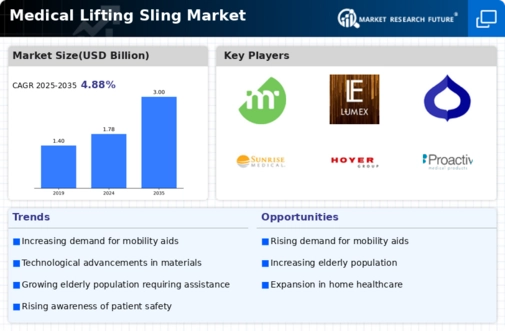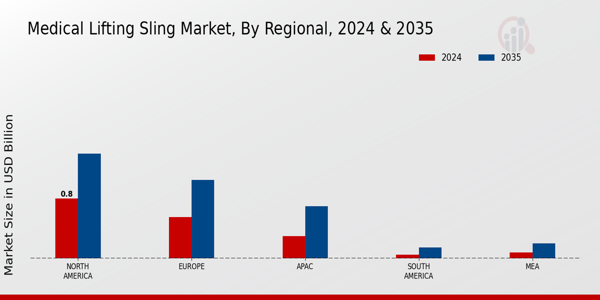Market Growth Projections
The Global Medical Lifting Sling Market Industry is projected to experience substantial growth over the next decade. With a market valuation of 1.78 USD Billion in 2024, it is expected to reach 3 USD Billion by 2035, reflecting a compound annual growth rate of 4.86% from 2025 to 2035. This growth trajectory indicates a robust demand for lifting slings driven by various factors, including technological advancements, increasing healthcare needs, and a focus on patient safety. The market's expansion presents opportunities for manufacturers and healthcare providers to innovate and improve lifting solutions for diverse patient populations.
Growing Awareness of Patient Safety
Growing awareness of patient safety and comfort is a crucial driver for the Global Medical Lifting Sling Market Industry. Healthcare providers are increasingly recognizing the importance of using appropriate lifting equipment to prevent injuries to both patients and caregivers. This heightened awareness leads to the adoption of lifting slings as standard practice in various healthcare settings. Training programs and educational initiatives further emphasize the significance of using lifting slings correctly, thereby enhancing their acceptance among healthcare professionals. As patient safety remains a priority, the demand for high-quality lifting slings is expected to rise, contributing to market growth.
Rising Incidence of Mobility Disorders
The Global Medical Lifting Sling Market Industry is significantly influenced by the rising incidence of mobility disorders, including arthritis, stroke, and other conditions that impair movement. As the global population ages, the prevalence of these disorders increases, necessitating the use of medical lifting slings for patient transfers and mobility assistance. This growing need for mobility support drives market demand, as healthcare facilities seek effective solutions to enhance patient care. The increasing awareness of the benefits of using lifting slings in rehabilitation and daily care further propels market growth, indicating a robust future for this segment.
Increasing Demand for Home Healthcare Solutions
The Global Medical Lifting Sling Market Industry experiences a surge in demand for home healthcare solutions, driven by an aging population and a growing preference for in-home care. As individuals seek to maintain independence while receiving medical assistance, lifting slings become essential tools for caregivers. In 2024, the market is valued at 1.78 USD Billion, reflecting the increasing reliance on home healthcare. This trend is expected to continue, with projections indicating a market growth to 3 USD Billion by 2035. The compound annual growth rate of 4.86% from 2025 to 2035 highlights the potential for innovation and expansion in this sector.
Technological Advancements in Medical Equipment
Technological advancements play a pivotal role in shaping the Global Medical Lifting Sling Market Industry. Innovations in materials and design enhance the functionality and safety of lifting slings, making them more user-friendly and efficient. For instance, the introduction of lightweight, durable fabrics and ergonomic designs improves patient comfort and caregiver ease. These advancements not only increase the adoption of lifting slings in healthcare settings but also contribute to the overall market growth. As healthcare providers prioritize patient safety and comfort, the demand for technologically advanced lifting slings is likely to rise, further driving market expansion.
Government Initiatives and Funding for Healthcare
Government initiatives and funding for healthcare significantly impact the Global Medical Lifting Sling Market Industry. Many governments worldwide are investing in healthcare infrastructure and supporting programs aimed at improving patient care. These initiatives often include funding for medical equipment, including lifting slings, to enhance the quality of care in hospitals and home settings. Such support not only increases the accessibility of lifting slings but also encourages healthcare providers to adopt these essential tools. As a result, the market is poised for growth, driven by favorable government policies and funding opportunities.














